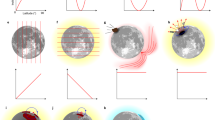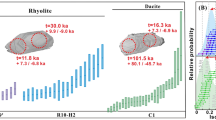Abstract
As part of an investigation to determine the age of the hominidbearing strata of the Hadar Formation of Ethiopia we have determined the magnetostratigraphy of two separate sections of the strata. Two major zones of reversed polarity occur within the predominantly normally magnetized sequence, one at the top and the other in the middle. There are difficulties with the absolute age determinations of volcanic units within the strata which result in uncertainties in correlating the Hadar magnetostratigraphy with the standard magnetic reversal time scale. The age of the upper part of the section is established by the BKT-2 tuff at ∼2.8 Myr (refs 1–4). The K–Ar dating of the Kadada Moumou basalt which lies in the middle of the sequence yields variable results ranging from 3.1 to 3.6 Myr (refs 1–4). Regional geochemical5 and bio-stratigraphical6 studies suggest the younger age for the Kadada Moumou basalt. We show here that this is also the age that results in the most consistent interpretation of the observed magneto-stratigraphy of the formation, which is that the Hadar Formation was deposited during the Gauss Normal epoch and that the two reversals represent the Kaena and Mammoth events within that epoch.
This is a preview of subscription content, access via your institution
Access options
Subscribe to this journal
Receive 51 print issues and online access
$199.00 per year
only $3.90 per issue
Buy this article
- Purchase on Springer Link
- Instant access to full article PDF
Prices may be subject to local taxes which are calculated during checkout
Similar content being viewed by others
References
Taieb, M. et al. Nature 260, 289–293 (1976).
Aronson, J. L. et al. Nature 267, 322–327 (1977).
Walter, R. C. thesis, Case Western Reserve Univ. (1980).
Walter, R. C. & Aronson, J. L. Nature 296, 122–127 (1982).
Brown, F. H. Nature 300, 631–633 (1982).
Boaz, N. T. Nature 300, 633–635 (1982).
Schmitt, T. J. et al. Proc. VIII Pan-African Cong. Prehist Quat. Stud., Nairobi (eds Leakey, R. E. & Ogot, B. A.) (National Museum of Kenya, 1980).
Mankinen, E. A. & Dalrymple, G. B. J. geophys. Res. 84, 615–626 (1979).
Taieb, M. & Tiercelin, J. J. Bull. Soc. geol. Fr. 1, 243–252 (1979).
Aronson, J. L. & Taieb, M. in Hominid Sites: Their Paleoenvironmental Settings (eds Rapp, G. & Vondra, C.) (American Association for the Advancement of Science, 1981).
Author information
Authors and Affiliations
Rights and permissions
About this article
Cite this article
Schmitt, T., Nairn, A. Interpretations of the magnetostratigraphy of the Hadar hominid site, Ethiopia. Nature 309, 704–706 (1984). https://doi.org/10.1038/309704a0
Received:
Accepted:
Issue Date:
DOI: https://doi.org/10.1038/309704a0
This article is cited by
-
Magnetostratigraphy of the lower member of the hadar formation (Ethiopia): Evidence for a short normal event in the mammoth subchron
Studia Geophysica et Geodætica (1996)
-
Early hominid from Baringo, Kenya
Nature (1985)
Comments
By submitting a comment you agree to abide by our Terms and Community Guidelines. If you find something abusive or that does not comply with our terms or guidelines please flag it as inappropriate.



